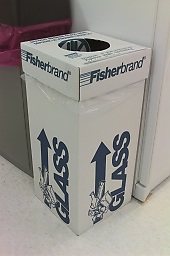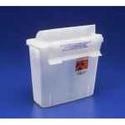Sharps in laboratories include needles, scalpel blades, razor blades, and broken wafers. Waste glass including pasteur pipets and glass containers, broken or not, must be disposed in appropriate containers, not the general waste. The first question to be answered when disposing of sharps or glass is: Is it biohazardous or radioactive?
Non-biohazardous or non-radioactive glass must be disposed of in glass disposal boxes, whether it is broken or not. When full, these containers are taped closed and disposed in the building waste dumpster by the lab users.

Biohazardous glass waste must be decontaminated chemically or by autoclaving prior to disposal as glass waste (above). Biohazardous glass pasteur pipets are best disposed in a sharps container, below.
Glass waste which is contaminated with radioactive material must be disposed of in containers provided by the Office of Radiological Safety (ORS). ORS should also be contacted for removal of these containers.
Needles, razor blades, scalpel blades, etc. can puncture cardboard boxes and must be disposed of in a plastic receptacle.
If the sharps are also biohazardous, a red sharps container must be used. When full, these containers can be placed in the hazardous waste area of the lab and request a pick up by EHS (see below).
Radioactive sharps must be contained in sharps containers provided by the Office of Radiological Safety (ORS). ORS should also be contacted for removal of these containers

Non-biohazardous/ non-radioactive sharps may be discarded in plastic containers that are any color EXCEPT red. These containers may be placed in the hazardous waste area and request a pick up by EHS (see below).
How to request a sharps container pickup.

PLEASE REMEMBER!
Sharps and glass in the regular trash can injure the people who pick up your trash. Please think of others when you discard these items and discard them into the appropriate containers!